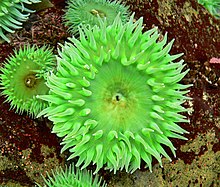Zoochlorella
| Zoochlorella | |
|---|---|
| Scientific classification (obsolete) | |
| (unranked): | Viridiplantae |
| Division: | Chlorophyta |
| Class: | Trebouxiophyceae |
| Order: | Chlorellales |
| Family: | Chlorellaceae |
| Genus: | Zoochlorella K.Brandt , 1881, nom. rejic.
|
Zoochlorella (pl.: zoochlorellae) is a coloquial term for any green algae that lives symbiotically within the body of an aquatic invertebrate animal or a protozoan.[1]
Classification
Zoochlorellae are various genera belonging to the classes
nomen rejiciendum. As a consequence, the two species belonging to this obsolete genus have been transferred to different green algal genera.[1]
- Zoochlorella conductrix K. Brandt → Micractinium Fresen.
- Zoochlorella parasitica K. Brandt → Choricystis (Skuja) Fott.
Origin
The analogy between zoochlorellae and chloroplasts was used by the botanist Konstantin Mereschkowski in 1905 to argue about the symbiotic origin of chloroplasts (then called 'chromatophores', a term used for completely different structures today).[3]
Occurrence
In animals

Zoochlorellae are responsible for the
Anthopleura elegantissima and Anthopleura xanthogrammica
.
In protists
Four species of distantly related
Stramenopiles; and Placocista spinosa, a filose amoeba belonging to the order Euglyphida within the phylum Cercozoa.[4]
Various
ciliates present zoochlorellae, such as the genera Paramecium, Stentor, Climacostomum, Coleps and Euplotes.[1]
In the centrohelid Acanthocystis turfacea lives a unique zoochlorella species known as Chlorella heliozoae.[1]
References
- ^ .
- JSTOR 1224630.
- ^ Martin W, and Kowallik, K V. 1999, Annotated English translation of Mereschkowsky's 1905 paper 'Über Nature und Ursprung der Chromatophoren im Pflanzenreich'. Eur. J. Phycol., 34: 287-295. Free access to the article Archived March 19, 2012, at the Wayback Machine
- .
